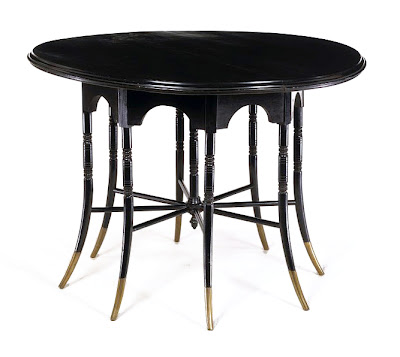 |
| perhaps a Josef Hoffman? No! its from 1867! |
 |
| table by Godwin, 1876. those brass tipped legs! |
 |
| It's not 1950s Blenko, its 1890 Dresser! |
 |
| folding chair by Godwin, 1875 |
 |
| chair, Godwin, 1883 |
 |
| chair, Dresser, 1880-83 |
 |
| toast rack, Dresser, 1878 |
 |
| occasional table, Godwin, 1876 |
 |
| Christopher Dresser |
 |
| Edward William Godwin |
Update: I got a great book suggestion from reader Will Chandler:
Nineteenth Century Modern: The Functional Tradition in Victorian Design by Herwin Schaefer, published 1970— a rather early foray into this kind of serious study of Victorian design.
Will elaborates:
His book focuses on the mostly vernacular and mechanical objects made in
Europe and the United States (some as far back as the 16th Century)
that inspired many of the early design reform theorists, and outlines
their responses to and comments about these sources. The book is heavily
illustrated and I've never seen a better exposition of this topic.
Schaefer was the first Design Collection curator at MOMA— so this sounds excellent. It's already on its way to me!
Also, somehow I've managed to be unaware until now that there is
an exhibit on “19th century Modern” at the Brooklyn Museum. I marvel at my obliviousness sometimes. I will append any thoughts I have on the exhibit here. //
The other day I came upon a post about architect and design reformer
Edward William Godwin (1833 – 1886) on an appealing interiors and design blog called
Hunters & Gatherers at Home. I already knew about Godwin, but H&G’s post really reminded me of the revolutionary quality of some of his work. Also included here, the more famous polymath
Christopher Dresser (1834–1904). I think these pieces are astonishing.
Godwin picked up architecture on his own. Dresser studied at the then brand new (and oddly fascist sounding) Government Schools of Design. Created in 1837 to better integrate science and art, the school's aim was to improve design for industry and manufacture. Can you imagine? In this country people were too busy displacing Indians, preserving slavery and clearing brush to care about something as rarefied as design. (Perhaps I overstate.)
Godwin steeped himself in Gothic Revival for a time but both he and Dresser really found themselves when they discovered Japanese crafts and decorative arts. Japan opened to trade with the West in 1853, and suddenly Japanese items flooded the market. All the design reformers, artists, and Aesthetic hipsters of the time went Japan-mad. It remained a cultural influence through the rest of the 19th century.//
Godwin created the crazy sideboard at top in 1867 for his own home. He explained:
"When I came to furniture I found that hardly anything could be bought
ready-made that
was at all suitable to the requirements of the case. l
therefore set to work and designed a lot of furniture...."
Lest you need reminding, this is the type of thing Godwin might have felt wasn't quite right:
 |
| cabinet, Herter Brothers, c. 1872 |




























